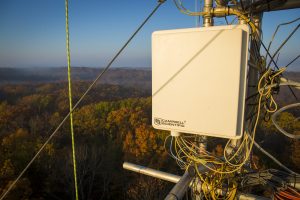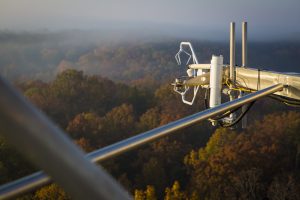This story also appears in our University of Missouri College of Agriculture, Food and Natural Resources’ Agricultural Research Center Magazine. Stop by your local Research Center to pick up a copy! You can view the magazine online by clicking here: Road to Discovery.
The Baskett Research Center is used as an outdoor laboratory for several classes, including dendrology, ornithology and resource measurements, and it has been the
study location for more than 125 publications.
Students and faculty work together on a variety of projects, including the development of strategies to mitigate invasive species, wildlife population research, investigation into predation and predatory patterns, the absorption of carbon dioxide in natural environments and much more.
One of those projects is MOFLUX, where collaboration is taking place on a research project that measures the carbon and water balance of Missouri’s oak-hickory forests on a large scale. That collaboration is between the MU School of Natural Resources, the Environmental Sciences Division of Oak Ridge National Laboratory, and the Atmospheric Turbulence and Diffusion Division of NOAA.

carbon dioxide, water vapor and meteorological information.
This Department of Energy-funded study, an addition to an existing network of “AmeriFlux” sites, employs a 106-foot tower outfitted with sophisticated analytical equipment measuring carbon dioxide, water vapor and meteorological information.
“One of the broader goals is to have observations of ecosystem functioning,” said Jeff Wood, assistant research professor in the School of Natural Resources and overseer of the MOFLUX tower at Baskett. “We measure on a scale from the leaf to the whole ecosystem. There are a range of manual and automatic measurements.”
These data can be used to estimate the carbon dioxide and water vapor exchange of up to 250 acres of forest, giving an ecosystem-level answer to when forests are sources and sinks of carbon dioxide.
The project undertakes comparative studies with other AmeriFlux sites to examine how carbon dioxide uptake (by photosynthesis) and release (by respiration)
change along important climate and vegetation gradients. Also supported by the project are ongoing, long-term ecosystem succession studies at Baskett to
document historical forest development and forest dynamics at the site.
“We’ve seen the exciting potential of this site and the research,” Wood said. “There is a big area of interest in several different branches of ecosystem science
and plant science. We’re in an interesting location for those.”
The tower at Baskett was established in 2004 and the first data became available then. Several data points are collected and that information is submitted to
AmeriFlux. AmeriFlux collects data from hundreds of sites, with the goal of developing baseline data markers for a variety of locations and forest types. There are
hundreds of towers and sites that feed into regional AmeriFlux networks, that then feed into a global network.
“We take a lot of measurements that are used to help understand that baseline,” Wood said. “We have vegetation plots where we track the inventory and composition of the forest, as well as other variables, such as leaf water potential, and other standard data.”
Wood estimates that the funding from the Environmental Sciences Division of Oak Ridge National Laboratory has been more than $2 million since Baskett’s tower went up. The funding cycle is a renewal process that happens every three or four years.
“During that renewal process, we talk about what we’ve done and explain what our future research plans are,” Wood said. “This is also an opportunity to bring in new activities, as well as build on current projects. There are times where we’ve spent a few years building theory and creating baseline data numbers. With the renewal, we can continue to interpret what we’re seeing.”
From an AmeriFlux perspective, the Baskett Research Center features the only tower in Missouri that feeds data to that network. There are similar towers in the state; however, they are part of other networks.

the first data became available then. Several data points are collected and that information is submitted to AmeriFlux. AmeriFlux collects data from hundreds of
sites, with the goal of developing baseline data markers for a variety of locations and forest types. There are hundreds of towers and sites that feed into regional AmeriFlux networks, that then feed into a global network.
“The other networks are funded differently,” Wood said. “They take in similar measurements. Basically, everyone tries to play nice. This is a coalition of the willing where each does their best to share the data we collect.”
Some of those towers are strictly agriculture related, while the Baskett MOFLUX tower is forest focused. Wood said he collaborates with a few of the ag-related tower operators.
“I come from an ag background, so I know about the tradeoffs with the two types of towers,” Wood said. “For the ag towers, you can put a tripod up in a field and collect data. In the forest, we have to get to the top of the canopy, so a massive tower is the only way to collect data. That allows our towers in the forest to collect a lot more data, though, since we can see the entire forest. The towers set up in a field can’t collect as much data.”
The data collected are publicly available for interested parties. Wood said that the majority of data requests come from other researchers.
“You have to send an email and follow their data policies,” he said. “You also have to explain your intended use. Generally, the requests for data are researchers trying
to find data from numerous sites. They’re doing a site synthesis analysis, and that takes hundreds of sites. Researchers could also be trying to validate models.”
Results from this study showcase how Missouri forests work, including possible impacts from drought events or other climate extremes. Given the large forest industry and conservation focus of the state, these findings are important for local forest management as well as broad, global scientific questions about forest ecosystem function.
“At the end of the day, the data we’re collecting is important to not only gain an understanding of what is happening in the forest, it is vital for other researchers who
are trying to do large-scale research projects,” Wood said.